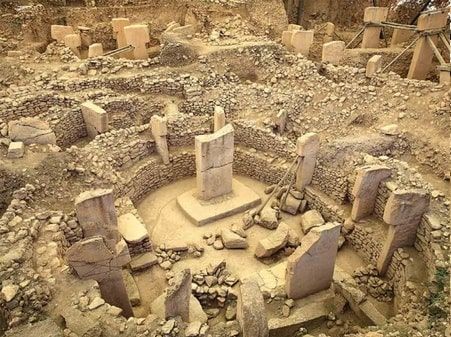Göbekli Tepe, the oldest temple in the world is in Turkey
This monumental ensemble records the era when humanity began to cultivate the land.
It is probably the oldest temple in the world: the Göbekli Tepe monumental complex in southeastern Turkey is almost 12,000 years old and marks the time when humanity was discovering the domestication of animals and the cultivation of plants, the basis for its future development.

The arid hill, a dozen kilometers northeast of the city of Sanliurfa, is home to several circular structures made up of ten stone pillars, carved in the shape of T, up to 5.5 meters high. Although only four sets have been excavated to date, georadar analyses indicate that there are still 16 more underground.
But the most striking thing is not the size of the monoliths, but their decoration: reliefs and engravings of foxes, bulls, lions, cranes, ducks, snakes, and once human, a fauna carved in limestone in an era without metals. Only with basalt or flint tools.
Last year Unesco registered Göbekli Tepe as a World Cultural Heritage Site and since then the site has been open to visitors and access has been built for visitors and awnings that protect the whole.
The discovery of the sanctuary, which the German Archaeological Institute (DAI) has excavated since 1990, has broken many concepts of archaeology. It shows that the societies of the time, which barely left the hunter-gatherer phase behind, were already able to organize themselves to build huge monuments.
Until now it was thought that at that time humans lived together in groups of about 15 people, without specialization in trades, but to build Göbekli Tepe you need hundreds of well-coordinated people," says Turkish archaeologist Devrim Sönmez, a researcher at the DAI in Istanbul.
Perhaps it was precisely the need to keep a large group of people in the same place for years - essential for cutting stones, transporting them, and erecting them - that drove the shift from ancient nomadism to sedentarism. In any case, just at the time when Göbekli Tepe was erected, from 9,500 BC, there are indications of the domestication of animals and the cultivation of plants in this region of Anatolia, now Turkey.
However, the builders still did not know about ceramics, or rather, they still did not use them to make containers, although they did use figurines, says Sönmez. And they knew textiles, beaded necklaces, and fine bone tools.
People tend to think that humans were primitive at that time, but their brain capacity was similar to today's, they were creative and knew how to solve problems very well," he adds.
Carving monoliths weighing more than ten tons into nearby rock formations, moving them a hundred meters uphill, and placing them in a circle required admirable planning and coordination.

"The most mysterious thing is that we do not know where the builders lived: on the hill, there are traces of places of fire and food, which could have been part of a ritual, but not of permanent homes or a continuous settlement. But there are cistern structures to provide water for the place," he says.
Göbekli Tepe has been compared by experts to Stonehenge, but apart from the fact that the anatolian monument is six millennia older, its huge stone pillars may have had a roof and formed a closed enclosure.
In turn, the archaeologist is skeptical of recent theories that the animal sets on the pillars represented constellations of stars. "Of course, stars were very important to humans at this time and they certainly knew them well, but we have no evidence to say that precisely these reliefs or the alignment of the stones are related to astronomy.
Nevertheless, this site can still hold many surprises: so far it is estimated that only five percent has been excavated.
Unusual geometrical complexity of the oldest temple in the world
The geometrical complexity of Göbekli Tepe, the oldest temple in the world, is a surprise to scientists and also a great mystery: how could a neo-socialist society build such a thing? Since it was discovered by German professor Klaus Schmidt in 1994, its construction has been attributed to hunter-gatherer populations 11,500 years ago, even 6,500 years before the great pyramids of Egypt.

But the arrangement of its pillars and its decoration indicates that it must have been of a complex civilization, something that scientists did not believe possible at that time. So who built it, and how? Now some Israeli scientists found a clue that could reveal some of the unknowns hidden in Göbekli Tepe.
Göbekli Tepe is an archaeological site formed by a series of circular and rectangular megalithic monuments arranged in the form of enclosures located in the province of Sanliurfa, in southwestern Turkey.
It was one of the most important discoveries about the Neolithic, the last of the Stone Age periods, and was declared a World Heritage Site by UNESCO in 2018. Its rooms, probably used for the execution of rituals, have high pillars of about 5.5 meters high in the form of T with wild animals carved. So far, most researchers have argued that the Göbekli Tepe enclosures in the main excavation area were built over time.
But researchers Gil Haklay, of the Israel Antiquities Authority, and Professor Avi Gopher, of the Department of Archaeology and Ancient Near Eastern Civilizations at Tel Aviv University (TAU), do not believe this was the case. For Haklay and Gopher, the geometric design of the site's impressive round stone structures and the huge set of limestone pillars were initially planned as a single structure.
According to Haklay and Gopher, the most remarkable thing is that the central points of the three most important spaces of Göbekli Tepe, designated as enclosures B, C, and D, seem to be linked geometrically, in an almost perfect equilateral triangle, something that researchers suggest could mean a hierarchical relationship between the spaces. The scientists reached this conclusion after using a computer algorithm to track aspects of the architectural design processes involved in the construction of these enclosures.
"Göbekli Tepe is an archaeological marvel (...) However, its architectural complexity is very unusual," explains Professor Gopher in a TAU statement and whose research was published in the Cambridge Archaeological Journal.
But this thesis of Haklay and Gopher that the structures were designed as a single project and according to a coherent geometric pattern would be something very advanced for the hunter-gatherers of the Neolithic.
"This research opens the door to new interpretations of this site in general and of the nature of its megalithic anthropomorphic pillars specifically," says Gopher.
It was traditionally believed that certain planning skills and practices, such as the use of geometry and the formulation of floor plans, emerged much later than the period during which Göbekli Tepe was built. Specifically, after hunter-gatherers became agricultural producers some 10,500 years ago. One of the characteristics of the first farmers is even the use of rectangular architecture.
"This case of early architectural planning can serve as an example of the dynamics of cultural change during the early parts of the Neolithic period," says researcher Haklay.
"Our new research indicates that architectural planning methods, abstract design rules, and organizational patterns were already being used during this period," he says.




